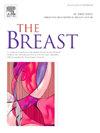机器学习预测模型对临床淋巴结阳性乳腺癌新辅助化疗后前哨淋巴结活检假阴性率的影响
IF 7.9
2区 医学
Q1 OBSTETRICS & GYNECOLOGY
引用次数: 0
摘要
机器学习(ML)模型可用于预测临床淋巴结阳性(cN+)乳腺癌新辅助化疗(NAC)后腋窝病理完全缓解(pcr)。我们建立了一种ML模型,结合NAC前后的临床病理特征和腋窝超声特征来预测NAC治疗的cN +乳腺癌腋窝pCR的可能性。方法将接受NAC治疗的cN +乳腺癌患者分为训练组和验证组(7:3)。采用单因素和多因素logistic回归分析选择腋窝pCR的独立预测因子;建立了6个ML模型来预测pcr。另一个独立的前瞻性队列纳入126例患者,以评估假阴性病例,何时使用最佳模型来指导患者选择前哨淋巴结活检(SLNB)。结果共纳入614例乳腺癌患者。年龄、月经状况、NAC前cN分期、分子亚型、组织学分级、NAC后肿瘤缩小百分比、NAC前后淋巴结皮质增厚≥3mm是腋窝pCR的独立预测因子。多层感知器模型具有最好的稳定性和预测性能,在接收者工作特征曲线下的最大面积为0.801(训练)和0.774(验证)。当将该模型应用于独立检测队列以指导患者选择SLNB时,假阴性率从22.2%降至1.4%。结论建立了一种预测NAC术后cN +乳腺癌pCR的ML模型。ML模型显示,当用作临床判断的辅助手段时,可以降低单示踪剂SLNB的假阴性率。本文章由计算机程序翻译,如有差异,请以英文原文为准。
Effect of a machine learning prediction model on the false-negative rate of sentinel lymph node biopsy for clinically node-positive breast cancer after neoadjuvant chemotherapy
Background
Machine learning (ML) models can be used to predict axillary pathological complete responses (pCRs) in clinically node-positive (cN+) breast cancer after neoadjuvant chemotherapy (NAC). We developed an ML model combining clinicopathological characteristics and axillary ultrasound features before and after NAC to predict the possibility of axillary pCR in NAC-treated cN + breast cancer.
Methods
Patients with cN + breast cancer who received NAC were categorized into training and verification cohorts (7:3 ratio). Independent predictors of axillary pCR were selected using univariate and multivariate logistic regression analyses; six ML models were developed to predict pCRs. Another independent prospective cohort of 126 patients was enrolled to evaluate false-negative cases when the best-performing model was used to guide patient selection for sentinel lymph node biopsy (SLNB).
Results
Overall, 614 patients with breast cancer were included. Age, menstrual status, cN staging before NAC, molecular subtype, histological grade, tumor shrinkage percentage after NAC, and lymph node cortical thickening ≥3 mm before and after NAC were independent predictors of axillary pCR. A multilayer perceptron model had the best stability and predictive performance, yielding the highest area under the receiver operating characteristic curve of 0.801 (training) and 0.774 (validation). When applying this model to the independent test cohort to guide patient selection for SLNB, the false-negative rate was reduced from 22.2 % to 1.4 %.
Conclusion
We established an ML model with excellent performance to predict pCR in cN + breast cancer after NAC. The ML model demonstrated potential to reduce the false-negative rate of single-tracer SLNB when used as an adjunct to clinical judgment.
求助全文
通过发布文献求助,成功后即可免费获取论文全文。
去求助
来源期刊

Breast
医学-妇产科学
CiteScore
8.70
自引率
2.60%
发文量
165
审稿时长
59 days
期刊介绍:
The Breast is an international, multidisciplinary journal for researchers and clinicians, which focuses on translational and clinical research for the advancement of breast cancer prevention, diagnosis and treatment of all stages.
 求助内容:
求助内容: 应助结果提醒方式:
应助结果提醒方式:


